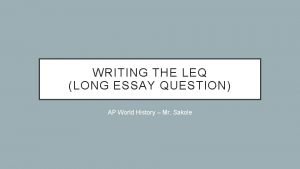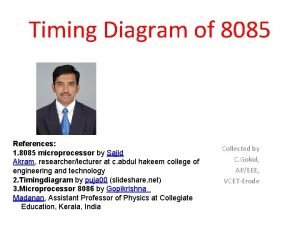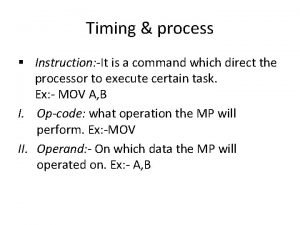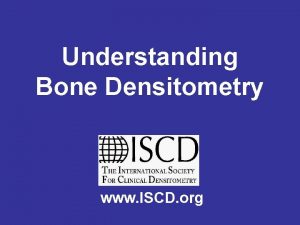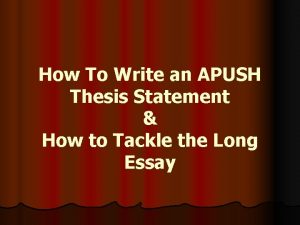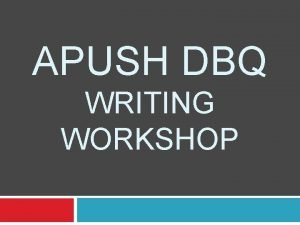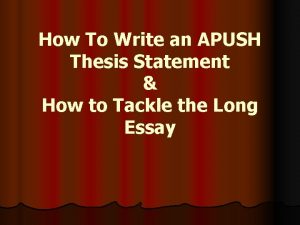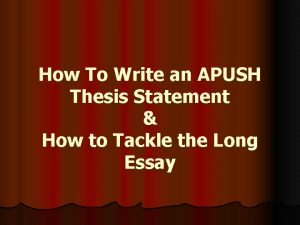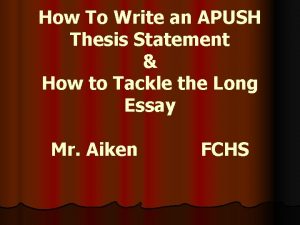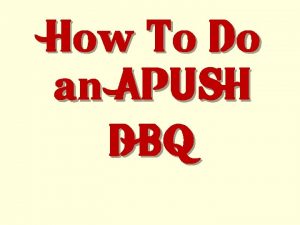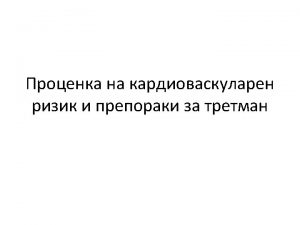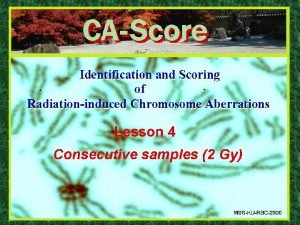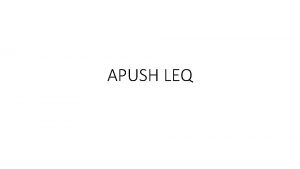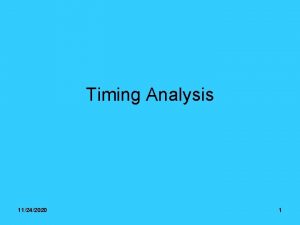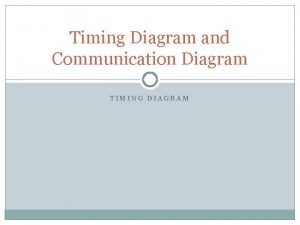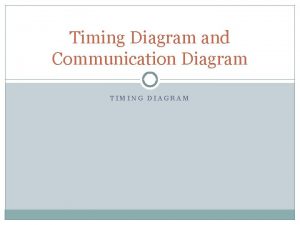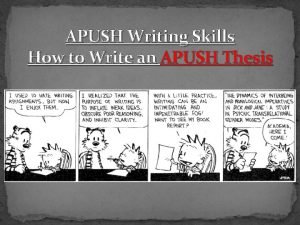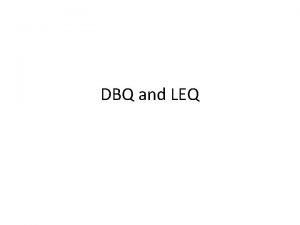How to Write the APUSH LEQ TIMING SCORE













- Slides: 13

How to Write the APUSH LEQ

TIMING/ SCORE • 35 Minutes (take 5 minutes to plan) • 15% of national exam score • Choose one of two possible questions • No documents- dependent solely on knowledge • LEQ graded on a scale of 1 -6…you want the 6!

HISTORICAL THINKING SKILLS (HTS) • All LEQ writing prompts will focus on one of four HTS… • You will earn 0 -2 points for how effectively you address the HTS in your essay • Historical Causation – identify, analyze, and evaluate the relationships among multiple historical causes and effects, distinguishing between those that are long term vs short term and among coincidence, causation, and correlation. • Periodization – connect historical events and processes to specific circumstances of time and place and to broader regional, national, and global processes. • Comparison – describe, compare, and evaluate multiple historical developments within one society, one or more developments across or between different societies, and in various chronological and geographic contexts. It also involves the ability to identify, compare, and evaluate multiple perspectives on a given historical experience. • Patterns of continuity and Change over time – recognize, analyze, and evaluate the dynamics of historical continuity and change over periods of time of varying lengths as well as the ability to relate these patterns to larger historical processes or themes.

THESIS • The thesis is the stance you are going to take on a given topic. In the body paragraphs of your LEQ, you will defend your thesis. • It is worth 1 point in your overall essay score • There are multiple ways to approach this but I like the formula X. However, A, B, and C. Therefore Y. • The nice thing about this formula is that it will not only address the prompt itself, but it will also address the complexity of the prompt. AP readers LOVE when that happens • Soooo……. . how does this formula work?

THESIS X. However, A, B, and C. Therefore Y. X= the strongest argument against your thesis. A= Your strongest point in defense of your thesis (paragraph 2 topic) B= Your second strongest point in defense of your thesis (paragraph 3 topic) C= Your third strongest point in defense of your thesis (paragraph 4 topic) Y= The position you will be taking throughout the essay

THESIS SUMMARY Prior to writing: 1. Make sure you understand the writing prompt 2. Identify the time frame 3. Identify operational function- (explain, analyze, etc. ) 4. Identify the HTS that needs to be addressed 5. Create a simple list of topics that could be included in your essay a. Choose the 2 -3 topics that would best support your thesis (They will be used later) Write: 2. X. However A, B, and C. Therefore Y. 3. Write your paragraph a. Provide a very broad overview of time period in question (1 -3 sentences) b. Follow formula (3 sentences) a. Be sure to bridge the context to your thesis formula

YOUR QUESTION: Evaluate the extent to which the Declaration of Independence marked a turning point in American history, analyzing what changed and what stayed the same from the period immediately before the declaration to the period immediately following it. 1. Analyze the question 2. Identify the HTS (be careful with this one…it’s not CCOT) 3. Sketch out your thesis statement 4. Fill in the context piece

PARAGRAPHS 2, 3, AND (MAYBE) 4 - THE BODY PARAGRAPHS • There is now more emphasis placed on this in grading. • 4 of the 6 points are commonly found here • Supporting arguments will be found here • 0 -2 points • HTS will (likely) be addressed in the body paragraphs • 0 -2 points • You may even address synthesis here, although that is more commonly found in the conclusion • This is where you will defend your thesis so it is crucial that you use your thesis as a guide. • Facts, Facts…. and then analysis, analysis! • Don’t forget to relate your data to the HTS • 0 -1 point

TYPICAL STRUCTURE OF THE BODY PARAGRAPHS • 1 st sentence is your topic sentence. All successful topic sentences will • Directly address the question • Introduce a particular category • Take a clear position on that category • The next 3 -5 sentences should be factual data followed by analysis of that data to support your thesis. Whatever data you bring in should be tied to your topic sentence (which will be tied to your thesis) • DON’T FORGET THE ANALYSIS…DON’T JUST LIST FACTS • Also tie these in to the target HTS • Finish with a “clincher” sentence that summarizes your arguments • Each paragraph should be 5 -7 sentences

CONCLUSION PARAGRAPH • Here is where you wrap everything up into one succinct paragraph • Conclusion formula: Therefore, Y. Y+BC is similar/different to OC because E. • Y= The position you took throughout the paper (your thesis) • BC= Broad Context…what is the big picture within the era you are writing about? • OC= Other Context…what other time period experienced a similar/comparable theme • E= Explanation

CONCLUSION PARAGRAPH Therefore, Y. Y+BC is similar/different to OC because E. • First: Restating your thesis in a new way. Therefore, Y. (1 sentence). Your first sentence should restate thesis in a fresh and interesting manner • • Second: Synthesis… (or Other Context) 1 -2 sentences connecting the events/era you discussed in your response to something else of note in a different era. Make sure that your OC topic has an appropriate connection. This will require you to think and demonstrate that you know history on a broader scale that what the question is asking • • Third: Explanation… 1 -2 sentences explaining how your theme/topic is similar or different than that same theme/topic in a different era. E = explanation (at least one strong piece of evidence to support your comparison)

SOME FINAL THOUGHTS • As stated earlier, there are other ways to write the LEQ. I like this because the formulaic approach is easy to follow • I would encourage you to look around and find other ways • https: //www. youtube. com/watch? v=w. Lwz. MZ 0 YUDA&list=PL-69 Th. Eyf 7 DKz. Ran. L 0 ZAL_Me. O 5 CAy. R 6 R • The ultimate goal is to simply answer the prompt by demonstrating that you understand the bigger picture of this event by connecting it to other things happening at the same time AND tying it to other moments in history that are comparable. • These are higher level thinking skills • This is why reading your text is so important! • To succeed on this exam, you have to make connections and go in depth, which is what the text does • I will provide resources throughout the year to help with this process

Total Score 6 points 15% of Total Score

